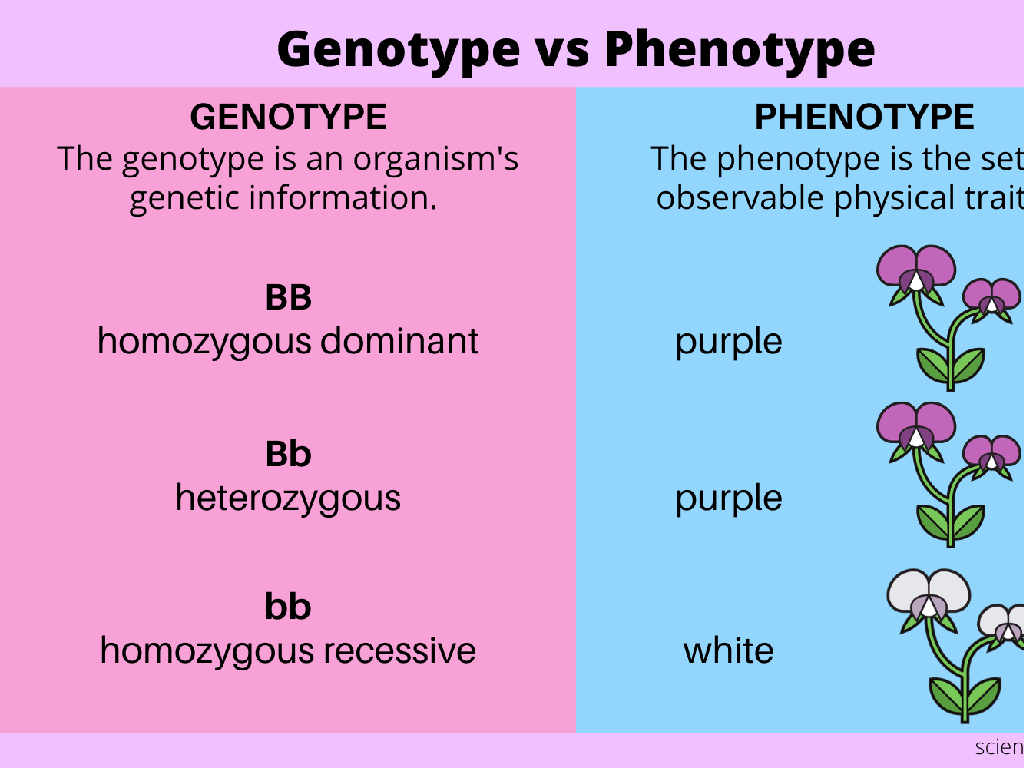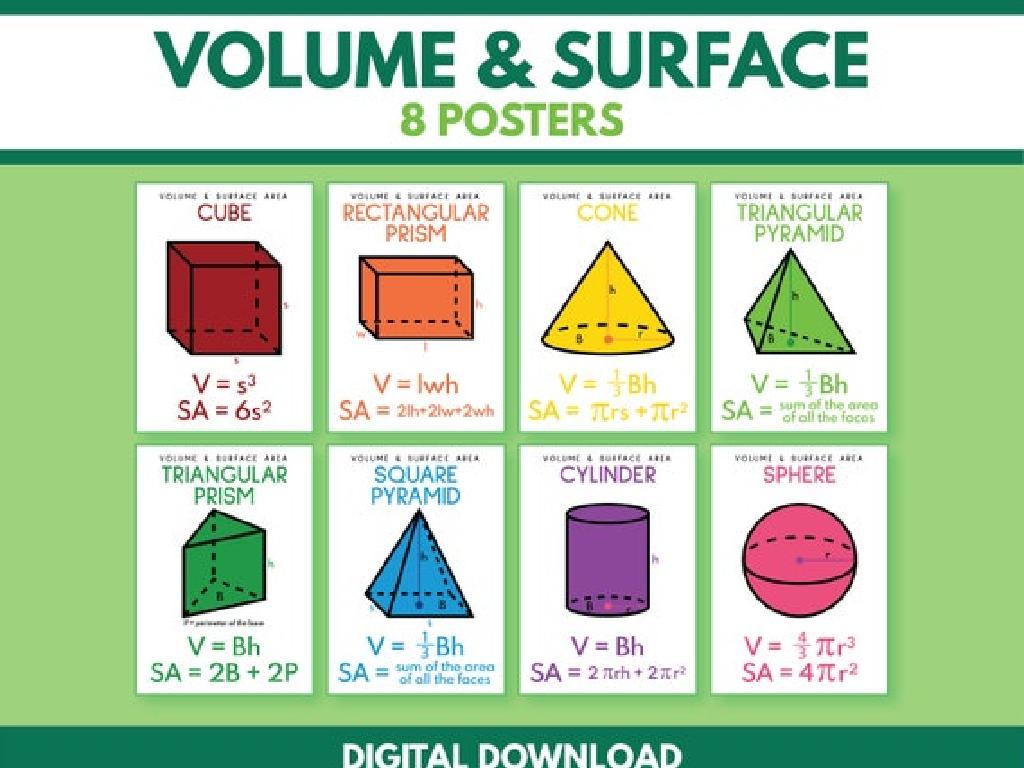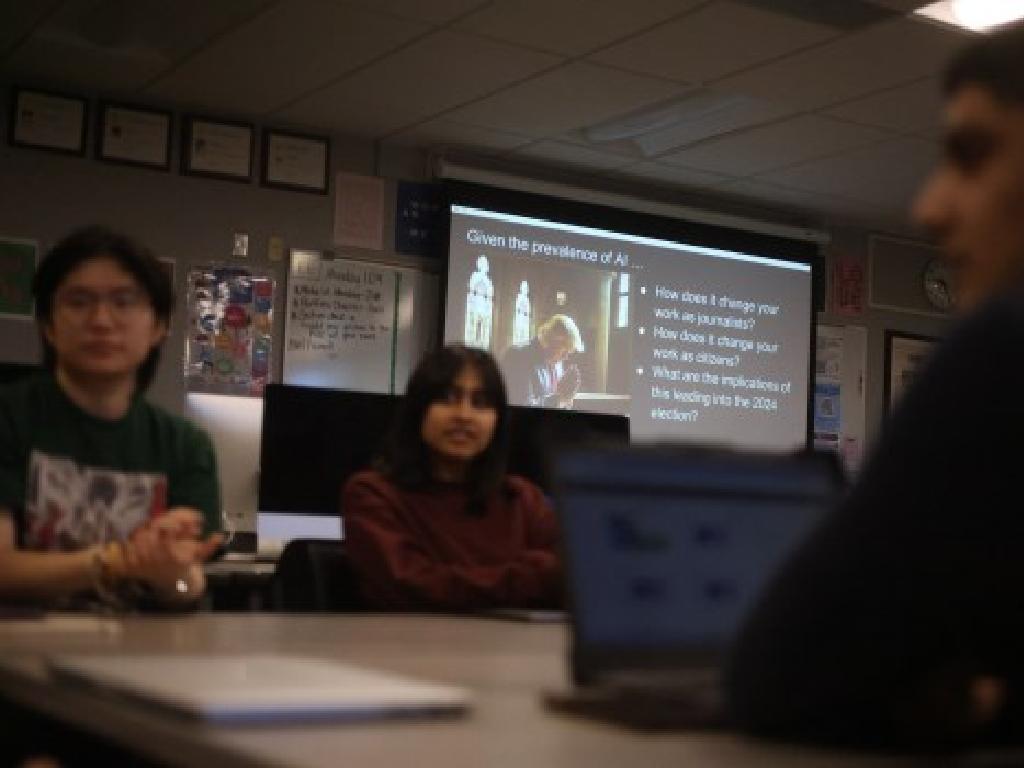Identify Steps Of The Scientific Method
Subject: Science
Grade: Sixth grade
Topic: Science Practices And Tools
Please LOG IN to download the presentation. Access is available to registered users only.
View More Content
Today’s Adventure: The Scientific Method
– What is the Scientific Method?
– A process for experimentation to explore observations and answer questions.
– Steps Scientists Use to Solve Problems
– Ask a question, do background research, construct a hypothesis, test with an experiment, analyze results, draw conclusions, and report results.
– Applying the Method to Experiments
– Use a plant growth experiment as an example: hypothesize that sunlight affects growth, test with varying light levels.
– Significance of the Scientific Method
– It’s a systematic approach to discovery that helps us understand the natural world.
|
This slide introduces the scientific method as a foundational concept in science that guides how scientists approach and solve problems. It’s crucial for students to grasp that the scientific method is a structured process that involves several steps, starting with curiosity and leading to conclusions that can be shared with the scientific community. Emphasize the importance of each step and how they connect to form a complete cycle of inquiry. Use relatable examples, like a plant growth experiment, to illustrate how the scientific method is applied in real-world scenarios. Encourage students to think of questions they could explore using the scientific method.
Exploring the Scientific Method
– Define the Scientific Method
– A process for experimentation to explore observations and answer questions.
– Systematic Approach to Inquiry
– Steps include asking a question, doing background research, constructing a hypothesis, testing with an experiment, analyzing results, and drawing conclusions.
– Example: Lemonade Stand Experiment
– Imagine testing which lemonade recipe gets more sales at your stand.
|
The Scientific Method is a foundational concept in science education, providing a structured approach for students to investigate and understand the world around them. Begin by defining the Scientific Method as a series of steps used by scientists to explore observations and answer questions. Emphasize the importance of a systematic approach to inquiry, which includes making observations, forming a hypothesis, conducting experiments, and analyzing results. Use the lemonade stand experiment as a relatable example for students to see how the Scientific Method can be applied in everyday life. They can hypothesize which lemonade recipe might be more popular and test it by selling different recipes at a stand. This practical example will help students grasp the concept and see the value of the Scientific Method in real-world scenarios.
Steps of the Scientific Method
– Step 1: Ask a Question
– Start with a curious question about your observations.
– Step 2: Do Background Research
– Gather information to understand the topic better.
– Step 3: Construct a Hypothesis
– Form an educated guess to answer your question.
|
This slide introduces the first three steps of the scientific method, which is a systematic approach to inquiry and discovery in science. Encourage students to think of a question that sparks their curiosity about the natural world. Emphasize the importance of doing thorough background research to inform their understanding of the subject. Guide them to construct a hypothesis, which is a tentative explanation that can be tested through experiments. Provide examples of each step to help students grasp the concepts. For instance, if a student wonders why plants grow towards light, they would research plant growth and light exposure before hypothesizing that plants grow towards light to receive more energy for photosynthesis.
Scientific Method: Experimentation & Conclusion
– Conduct an experiment to test hypothesis
– Follow your plan to see if your guess was correct
– Collect and analyze experimental data
– Look for patterns or changes that occur during the experiment
– Conclude if data supports the hypothesis
– Decide whether your original hypothesis was right or wrong
– Report findings and hypothesis validity
– Share results with others and discuss if your hypothesis was supported
|
This slide covers the critical steps of the scientific method where students put their hypotheses to the test. Step 4 involves conducting an experiment, which should be planned to minimize variables and ensure fair testing. Step 5 is where students will analyze the data collected during the experiment to look for evidence that either supports or refutes their hypothesis. In Step 6, students learn the importance of communicating their findings, regardless of the outcome, as this is essential for scientific progress. Encourage students to think critically about their data and to understand that disproving a hypothesis is also a valuable result in science. Provide examples of how to structure a report and the importance of peer review.
Asking Good Questions in Science
– What makes a good scientific question?
– It’s testable, measurable, and specific.
– Example: Sunlight’s effect on plants
– How might different sunlight levels change how a plant grows?
– Activity: Create your own question
– Share and discuss with the class
– We’ll discuss what makes your question scientific.
|
This slide introduces the concept of formulating scientific questions, a critical first step in the scientific method. A good scientific question should be clear, focused, and testable. It should lead to a hypothesis that can be investigated through experiments. For example, asking about the effect of sunlight on plant growth can lead to measurable experiments with different light conditions. The activity encourages students to think critically and come up with their own questions to explore, fostering curiosity and engagement. In the next class, students will share their questions and discuss the characteristics that make them suitable for scientific investigation. This will help them understand the importance of a well-structured question in the scientific process.
Conducting Background Research
– Find credible sources for research
– Use books, reputable websites, and scientific journals
– Organize notes effectively
– Use bullet points, summaries, and mind maps
– Class Activity: Investigate a science query
– Choose a question, find sources, and take notes
|
This slide introduces the step of conducting background research in the scientific method. Emphasize the importance of using reliable sources such as academic books, peer-reviewed journals, and trusted websites. Teach students how to take effective notes by organizing information into bullet points, summaries, and mind maps. For the class activity, guide students to select a scientific question of interest, research it using credible sources, and organize their findings. Provide detailed guidelines for the teacher on how to facilitate this activity, suggesting various research questions for diversity in student projects, and how to assist students in evaluating the credibility of their sources.
Formulating a Hypothesis
– Understanding a hypothesis
– A hypothesis is an educated guess to explain observations.
– Crafting a testable prediction
– It must be specific and measurable.
– Group activity: Create hypotheses
Each group will think of questions and predict outcomes.
– Sharing and discussing hypotheses
Groups will present their hypotheses and discuss.
|
This slide introduces the concept of a hypothesis in the scientific method. A hypothesis is essentially an educated guess based on observations and prior knowledge. It’s important for students to understand that a hypothesis should be testable; it must be framed in a way that allows for experimentation and observation to confirm or refute it. During the group activity, encourage students to ask questions about natural phenomena and then guide them to formulate clear, testable hypotheses. After creating their hypotheses, each group will share with the class, providing an opportunity for discussion and feedback. This activity will help students practice critical thinking and understand the role of a hypothesis in scientific inquiry.
Experimentation: The Scientific Method
– Designing a fair test
– A fair test changes one factor at a time while keeping others constant.
– Understanding experiment variables
– Variables include independent (changed), dependent (measured), and controlled (kept the same).
– Prioritizing safety in experiments
– Always wear safety gear and follow guidelines.
– Recording and analyzing data
|
This slide focuses on the experimentation phase of the scientific method. Emphasize the importance of designing a fair test, where only one variable is changed at a time to ensure reliable results. Discuss the different types of variables: independent variables which are changed by the scientist, dependent variables which are observed and measured, and controlled variables which are kept constant. Stress the importance of safety, including wearing protective equipment and understanding the potential hazards of the materials used in the experiment. Encourage students to think critically about how to record their observations and analyze the data they collect. Provide examples of fair tests and discuss how to handle variables.
Analyzing Data in Scientific Method
– Collect and record observations
– Identify patterns in results
– Look for trends or repetitions
– Interpret data meaningfully
– Draw conclusions from the patterns
– Example: Charting plant growth
– Record daily height of plants, observe growth trend over time
|
This slide focuses on the step of analyzing data within the scientific method. Students should understand the importance of meticulous data collection and the recording of observations. Emphasize the need to be thorough and accurate. Once data is collected, students should learn to look for patterns or trends that can help make sense of the results. For example, when charting plant growth, students can record the daily height of plants and then observe the growth trend over time. This can lead to conclusions about the conditions that affect plant growth. Encourage students to think critically about the data they collect and to ask questions that can lead to further experimentation and discovery.
Drawing Conclusions in the Scientific Method
– Interpreting your results
– Look at the data and ask what it means.
– Evaluating the hypothesis
– Decide if your initial guess was correct.
– Learning from the experiment
– Reflect on the process and identify improvements.
– Thinking about future experiments
– Consider changes to test the hypothesis again.
|
This slide focuses on the final step of the scientific method: drawing conclusions. Students should learn how to look at their results and interpret what the data is telling them about their hypothesis. They need to evaluate whether their hypothesis was supported by the results or not. It’s also crucial for them to reflect on the entire process to identify what they could do differently next time to either support their hypothesis better or to refine their experiment. Encourage students to think critically about their methods and consider alternative approaches for future experiments. This step is essential for understanding the iterative nature of scientific inquiry.
Reporting Results in Science
– Share findings with others
– Create a presentation or poster
– Use visuals and data to explain your experiment
– Understand peer review
– Peer review improves and validates your work
– Significance of sharing results
– It helps build knowledge and advance science
|
This slide emphasizes the importance of the final step in the scientific method: reporting results. Students should learn that sharing their findings is crucial for the collective advancement of scientific knowledge. They can do this through presentations or science fair posters, which should include clear visuals and data to communicate their experiment’s outcomes effectively. Peer review is also introduced as a process where other scientists evaluate the work to ensure its accuracy and reliability. Emphasize that sharing results is not just about getting credit for the work, but also about contributing to the scientific community and society’s understanding of the world.
Class Activity: Mini-Science Fair
– Apply the Scientific Method
– Work in groups on experiments
– Collaborate to design and conduct an experiment
– Test your hypotheses
– Observe results and see if they support your hypothesis
– Share findings with the class
– Prepare a presentation to explain your experiment and results
|
This class activity is designed to give students hands-on experience with the scientific method. Divide the class into small groups and allow them to choose a simple experiment to conduct. Each group should formulate a hypothesis, perform the experiment while documenting their methods and observations, and then analyze the results to see if their hypothesis is supported. Finally, each group will prepare a short presentation to share their findings with the class, fostering a mini-science fair atmosphere. Encourage creativity and ensure that each group understands the steps of the scientific method. Possible experiments could include testing plant growth with different fertilizers, observing chemical reactions with household items, or exploring physics concepts with simple machines.






